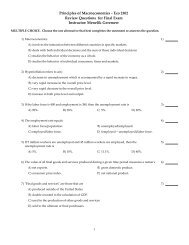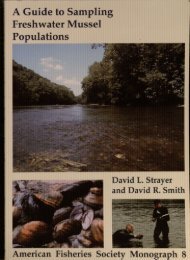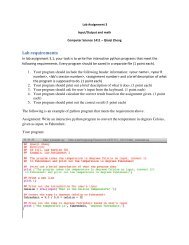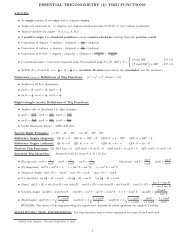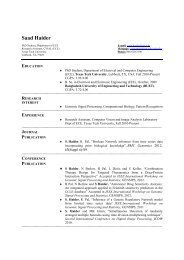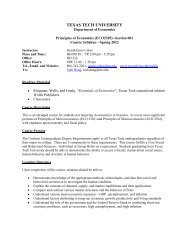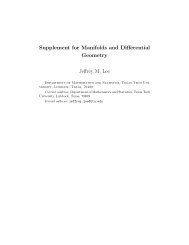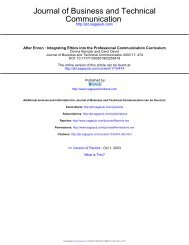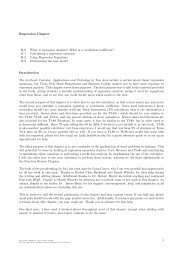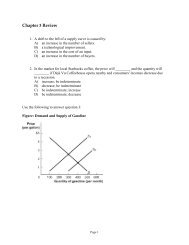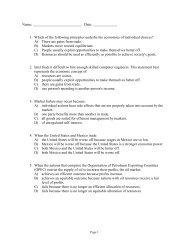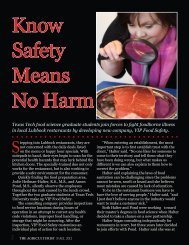Download - MyWeb - Texas Tech University
Download - MyWeb - Texas Tech University
Download - MyWeb - Texas Tech University
Create successful ePaper yourself
Turn your PDF publications into a flip-book with our unique Google optimized e-Paper software.
The 2012 Season of the Chan Chich Archaeological Project<br />
San José to Kaxil Uinic during Easter week in<br />
1931. As I argue in this chapter, the two sites<br />
are not the same place, and it is probable that<br />
Thompson never even saw the ruins that are<br />
today known as Chan Chich.<br />
Because, as it turns out, the historic village<br />
and the prehistoric Maya site of the same name<br />
are located 0.5 km apart, the two are spatially<br />
and temporally distinct entities, nevertheless<br />
linked by proximity and name. I treat them as<br />
such here, discussing first the historic village<br />
and second the prehistoric ruins. To minimize<br />
confusion, I refer to the historic settlement as<br />
Kaxil Uinic village and the prehistoric site as<br />
Kaxil Uinic ruins.<br />
A comment about the name shared by the two<br />
places is in order. The literature review and the<br />
archival study demonstrate that the name of the<br />
place is spelled in a wide variety of ways. In<br />
my research, I found it spelled “Kaxil Uinic”<br />
(Thompson 1939, 1963), “Kaxiluinic” (Jones<br />
1977), “Kaxilvinic” (Maler 1910: 151), “Kaxi<br />
Uinic” (Third Marshall Field Archaeological<br />
Expedition to British Honduras: Preliminary<br />
Report [3MFAEBH:PR], Field Museum<br />
Archives, Chicago [FM]), “Xaxe Venic”<br />
(Miller 1887; Colonial Secretary to Alcalde,<br />
Xaxe Venic, letter, [Colonial Secretary] March<br />
5, 1931, FM), “and “Kaxwinik” (Memorandum<br />
on a Proposed Maya Archaeological and<br />
Ethnological Expedition [Memorandum], 1931,<br />
FM), among others. Xaxe Venic is the earliest<br />
spelling I have found, on a map by William<br />
Miller published in 1887, and it appears that<br />
variation was preferred locally and by the Belize<br />
Estates and Produce Company, the landowner<br />
in the early 1900s. Even today, the name Xaxe<br />
Venic appears on signs and trail maps at Chan<br />
Chich Lodge. J. Eric Thompson, himself, may<br />
have been responsible for changing the name<br />
to Kaxil Uinic, which is Yucatec Mayan for<br />
“forest man” or “wild man.”<br />
The Historic Maya Village of<br />
Kaxil Uinic<br />
The Archival Evidence<br />
“Xaxe Venic” is depicted on an 1887 map<br />
published by William Miller as part of his<br />
official survey of the border between British<br />
Honduras and Guatemala in the late 1880s.<br />
Miller (1887:420) was one of several surveyors<br />
who oversaw the survey and cutting of the<br />
border between the two nations, noting in his<br />
report to the Royal Geographical Society that<br />
the boundary “has been cleared through the<br />
bush…and has been cut 12 feet wide.”<br />
Of interest on his map (Figure 4.1) are the<br />
roads shown connecting Kaxil Uinic to San<br />
José to the southeast, Yalloche in Guatemala to<br />
the southwest, Ycaiche in Mexico to the north,<br />
and the Peten to the west. Miller (1887:422–<br />
423) notes, “All the roads which I have marked<br />
are mere paths through the bush, the majority<br />
of them so bad that even a mule could not<br />
travel on them.” It is unclear how accurately<br />
drawn the roads are, however, or if Miller<br />
followed them all while working in the area.<br />
He notes that the “villages shown on the map<br />
are inhabited by Indians...The Indians of these<br />
villages are not savages. They cultivate the soil<br />
and grow maize, rice, and beans, and raise pigs<br />
and fowls” (Miller 1887:422).<br />
Another interesting element on the map is Chan<br />
Chich Creek (spelled Chan Chiich on the map,<br />
but Chan Cheëch in his report text). Chan Chich<br />
Creek begins in Guatemala where it is a series<br />
of small pools during the dry season. It and<br />
Little Chan Chich Creek both flow generally<br />
southwest to northeast, joining to become the<br />
Rio Bravo a few hundred meters north of the<br />
ruins of Chan Chich. The ruins, which take their<br />
name from the creek, are located on a bend in<br />
Chan Chich Creek, on its west bank. Near the<br />
ruins, the creek flows year round, being fed by<br />
small springs. Miller’s (1887:422) description<br />
32



